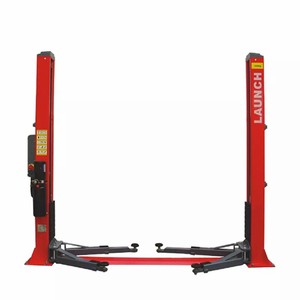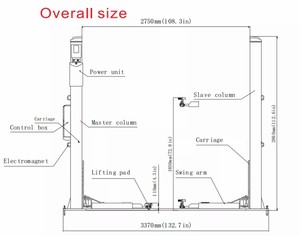(6377 products available)


































































































































































































































Parking cars elevador parking lifts are an essential tool for maximizing space in parking lots and garages. They come in several types, each designed to meet specific needs.
Two Post Parking Lift
Two-post parking lifts are the most popular type of lifts. They have two vertical posts with hydraulic arms that hold the car’s frame. These lifts are affordable, easy to install and maintain, and versatile. They can lift various cars, from small sedans to larger SUVs. However, the two-post lifts require enough space around the vehicle for the lift’s arms to be installed and operated.
Four Post Parking Lift
Four-post parking lifts have four vertical posts, one at each lift corner. They are more stable than two-post lifts, so they are often used for larger or heavier vehicles. Four-post lifts also have a higher weight capacity and can hold more weight than two-post lifts. They also require more space to operate and maintain. Four-post lifts are commonly used in car shows, exhibitions, or garages where cars need to be displayed.
Scissor Parking Lift
Scissor parking lifts have their lifting arms folded like scissors. They are compact and take up less space than other lifts. Scissor lifts are suitable for low-ceiling garages since they do not require much overhead space to operate. They also have a simple design, making them easy to maintain. However, scissor parking lifts have a lower weight capacity compared to other lifts.
Hydraulic Parking Lift
Hydraulic parking lifts use hydraulic systems to lift and lower vehicles. They are easy to operate and can lift cars smoothly and safely. Hydraulic lifts offer precise control over the lifting process. Some hydraulic lifts are portable, making them easy to transport and use in various locations. However, the hydraulic system requires regular maintenance to prevent leaks or ensure proper operation.
Rotary Parking Lift
Rotary parking lifts lift vehicles and rotate them to save parking space. They are ideal for areas with limited parking space, as they can park more cars in a smaller area by utilizing vertical space. Rotary lifts are commonly used in urban areas with high population density and limited parking space. They can be automatic or manually operated, depending on the design and requirement.
There is no one-size-fits-all specification for parking car elevators. Each model has its unique features that set it apart. Here are some common specifications to give an overview:
Load capacity
The load capacity refers to the maximum weight the parking lift can support. The specification is crucial since it ensures the safety and integrity of the structure. Exceeding the load capacity can lead to accidents and equipment failure. The common load capacity for residential elevators is 2000 lbs.
Elevator size
The dimensions of a car parking elevator are determined by various factors, including the design and model. The standard dimensions include width, height, and platform size. The elevator size must accommodate the parking space and vehicle size.
Drive system
The drive system is the mechanism that moves the elevator up and down. There are various types of drive systems, including hydraulic systems and traction systems. Each of the systems has its advantages, such as smooth operation and low maintenance costs.
Safety features
Safety is a critical aspect of parking car elevators. Various safety features are integrated into the elevator to ensure smooth and safe operation. Some of the features include emergency stop buttons, safety gates, and overload sensors.
Power requirements
The parking lift has power requirements based on the drive system and the elevator size. The power requirement is given in horsepower or kilowatts. The requirement must be met for optimal performance and operation of the parking lift.
Construction materials
The parking elevator lift is constructed with robust materials to ensure durability. The construction material also affects the maintenance requirements and the initial cost of the elevator. Common materials include steel and aluminum.
Proper maintenance of parking lot car elevators is key to their longevity and optimal performance. Here are the maintenance requirements:
Choosing the right parking lift for a specific need or business can be challenging but is very important. Here are some key factors to consider when choosing a parking car elevator.
Capacity:
The total weight of the cars and the number of cars to be parked should be considered. A larger and stronger parking car elevator should be selected if heavier cars are to be parked.
Space:
The parking lot's dimensions and available space for installation should be considered. A model with a compact design and a small footprint should be selected in cases of limited parking space.
Type of parking lift:
The specific needs and characteristics of the parking lot should be considered when selecting a suitable type of parking lift. For example, in cases where the parking space is limited, a parking lift with a vertical design should be selected to take advantage of the available height and offer more parking space.
Safety features:
Features like safety barriers, emergency stop buttons, and overload protection should be considered when selecting a parking car elevator with enhanced safety features. This is to ensure the safety of vehicles and personnel during operation.
Installation and maintenance:
The ease of installation and maintenance of the parking car elevator should be considered. Models that are easy to assemble, adjust, and clean should be selected to save time and costs.
Cost:
The budget and cost-effectiveness of the selected parking lift should be considered. A model offering high performance and low operating costs should be selected to maximize returns and long-term benefits.
There are detailed steps that should be followed when installing or replacing a parking car elevador.
Q1: Can trucks and larger vehicles use parking lifts?
A1: Some parking lifts are designed to accommodate larger vehicles like trucks and SUVs. However, a parking car elevador specifically rated for larger vehicles is required. Always check the weight and size capacity before using a parking lift for a larger vehicle.
Q2: Are there any safety concerns with using parking lifts?
A2: There are safety concerns, but when used properly, parking car elevadors can be safe. The primary concern is the potential for accidents if the lift fails or if the vehicle is not secured properly. Always follow the manufacturer's instructions and ensure the lift is well maintained to minimize these risks.
Q3: How much space is needed for a parking lift installation?
A3: The space required for a parking car elevador varies depending on the lift type and model. Generally, parking lifts require additional space for the lift's footprint and clearance above and below the lift. Consult the manufacturer's specifications to determine the exact space requirements for the chosen parking lift.
Q4: Can parking lifts be installed outdoors?
A4: While some parking lifts are designed for outdoor use, most are intended for indoor installation. Outdoor lifts must be built to withstand the elements, such as rain and snow. If an outdoor lift is required, select a parking car elevador specifically designed for outdoor use and weather resistance.
Q5: How often should parking lifts be maintained?
A5: Regular maintenance is essential to ensure the safety and functionality of parking lifts. The frequency of maintenance depends on the lift type and usage. Generally, follow the manufacturer's maintenance schedule and perform regular inspections and servicing to prevent potential problems and ensure the lift's optimal performance.